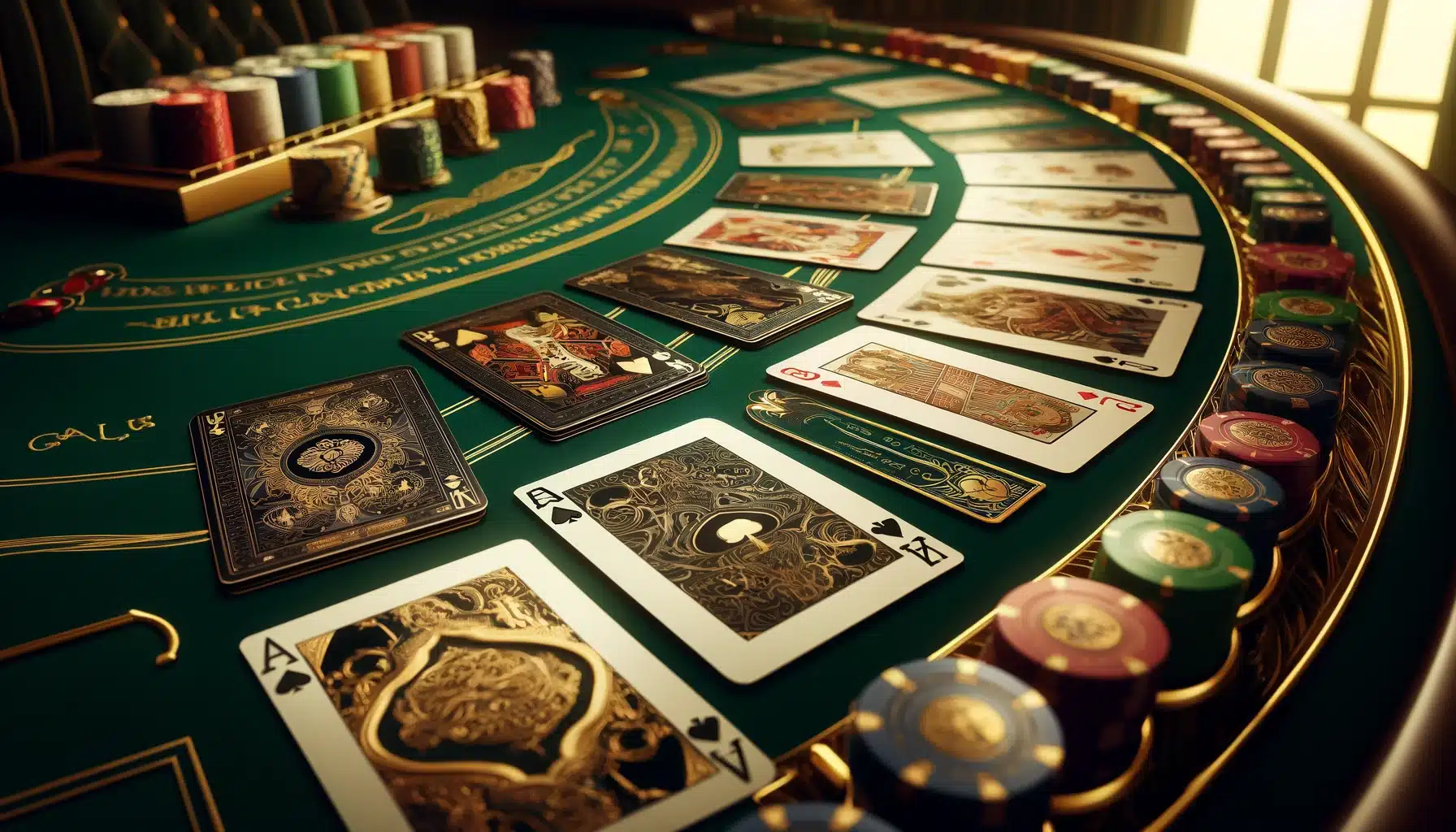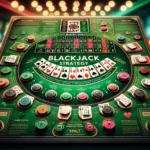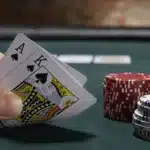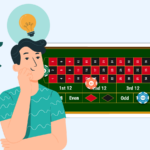Blackjack Card Values

Greetings, friends who love cards! I’m Mary from casinomary.com, and if you are a beginner at blackjack or just need to brush up on the basics, then you have come to the right place. Whether you are playing in a busy Las Vegas casino or sitting at home on your computer, understanding blackjack card values is key.
So let’s get into it – what exactly do we mean by “card values,” and why are they so important for strategy and success when playing blackjack?
Understanding Blackjack Card Values: The Basics
Welcome to the fundamentals of blackjack card values – where every aspiring player must start if they want to master this classic casino game.
Whether you’re sitting at a felt table surrounded by noise and excitement or playing alone online in your pajamas, knowing what each card is worth can make all the difference between winning big or losing everything.
The Basic Blackjack Card Values
In blackjack, any numbered card from 2 through 10 is taken at its face value, meaning that whatever number appears on that particular piece of cardboard represents how many points it’s worth.
For example, 2 = two points, 3 = three points, etc. This system couldn’t be simpler (or easier to remember), which makes it perfect for beginners learning hand calculations for the first time.
The Value of Face Cards
A King, Queen, or Jack is worth ten points each across all suits – Hearts, Diamonds, Spades, & Clubs. This uniformity speeds up decision-making during play as players don’t have to stop and think about what specific cards might be worth which amount since they’re all valued equally anyway (hence their name “face” cards!).
If any one of these three should appear before us, we need not even ask ourselves twice whether our next move ought to be hitting again or standing pat… because no matter where she lands, we know right off the bat that she’s worth ten flat!
This rule simplifies things tremendously and also has another nice side effect; it increases the frequency at which you’ll see hands with totals around 20-21, making for more exciting finishes.
The Dual Nature of Aces
In blackjack, an Ace can be either one point or eleven points – it’s up to the player. This means that if I have an Ace and a six in front of me, my total value is seventeen, even though, mathematically speaking, I should only count them as seven… This is because sometimes you want to make your hand look bigger than it really is in order to scare off opponents during betting rounds.
But what happens if, after hitting once more, we draw another nine? Suddenly, our sum jumps from twenty-three all the way up to thirty-five, thus forcing us to switch gears by setting aside our original plan and treating those ones from here on out like they’re just worth a single measly point apiece instead (bringing us down to sixteen).
The same logic can be applied in reverse when necessary – starting off small but gradually building towards something larger depending on how things are going elsewhere at any given moment throughout each game played.
This dual nature possessed by such cards makes them both powerful weapons capable of turning tide fortunes single-handedly while also posing dangers, such as sinking ships alone. It offers tactical depth into blackjack, thereby urging contenders to study ahead and reflect on several plausible outcomes per fresh card drawn.

The Role of Aces: Soft vs Hard Hands
Blackjack treats the Ace differently compared to all other cards since its values are twofold, namely, one or eleven. This particular feature greatly affects one’s strategy, considerably influencing whether one will win or lose. Therefore, knowing how best to manage these types of cards held in hands is termed as ‘soft’ and ‘hard.’
In blackjack, a soft hand is one in which an Ace can be counted as 11 without going over 21. It’s called ‘soft’ because it lets you draw further cards without the danger of busting. For example, if you have an Ace and a 6 (soft 17), you can hit to aim for a better total. If the next card is high, then you can change the value of your Ace to 1 so that you don’t go bust.
On the other hand, a hard hand either doesn’t contain an Ace at all or, if it does, that Ace can only be valued at 1 because counting it as 11 would take the total above 21. Hard hands are less flexible; if you take additional cards with them, then there’s more risk of busting. For instance, if you hold an Ace and a 9 (hard 10 or soft 20), and draw another card that’s a nine, then you must count the Ace as one so that you avoid busting — turning what was once a promising soft hand into a less flexible hard nineteen.
Strategic Implications
The difference between soft and hard hands is crucial for formulating successful blackjack strategies:
With a soft hand, your play can afford to be more aggressive. You know that hitting on such hands won’t lead to instant busts because there’s always the option of changing your Ace from an eleven down to one when necessary. This versatility allows players to take dynamic approaches towards reaching closer to twenty-one without immediately risking everything by going over (busting).
With hard hands, however, caution must prevail; they lack any kind of safety net. Therefore, if high cards are drawn after choosing ‘hit’ on numbers like sixteen or lower, then it becomes very easy to go bust in this scenario where strategy tends towards conservatism, especially when the dealer’s showing card suggests having a lower total hand.
Mastery of Ace Management
Being able to switch an Ace between 11 and 1 is a powerful skill in blackjack, but it requires good judgment and awareness of what the dealer might have.
Newcomers should learn how to tell whether their hand is soft or hard and make decisions based on that. This knowledge will not only improve your game but also greatly increase the chances of beating the dealer.
Tips for Mixing Up Different Blackjack Card Values
If you are playing blackjack, your strategy is highly influenced by the value of the cards in your hand. This value determines whether you should hit, stand, double down or split with regards to what the dealer is showing.
Here is how the knowledge about card values can be used to make strategic decisions that increase your chances of winning.
When To Hit Or Stand
Low Card Values (2-6): When you have a lot of low-value cards, it becomes less likely for one to bust if they take another card. For example, if you have a total of 12-16 and the dealer’s card is also low (2-6), then standing would be better since there is a high chance that the dealer will bust. But if the dealer shows a high card such as 7-Ace, then it’s worth considering hitting so as to try and improve your hand.
Mid-Range Card Values (7-9): These cards offer more flexibility because, depending on which card shows up against them, players can either hit or stand. If the dealer’s face-up card indicates that he has seven or higher, experts advise players with hands totaling around 12 through 16 inclusive not to stand but rather attempt getting closer to twenty-one without exceeding it by taking an additional card.
High Card Values (10, Face Cards): With high cards, the strategy changes; when holding a hard seventeen or above, most times, you should stay regardless of what the dealer shows because the risk of going over taking another one is too much.
Dealing With Aces
Soft Hands (Ace counted as 11): Always treat soft hands, especially those lower than seventeen, as opportunities for improving totals with least risks involved; e.g., if dealt an Ace and six, making seventeen soft total may draw any other face/ten value or nine etcetera where ace could still be counted one thus preventing from busting out.
Doubling Down
Optimal Doubling Down: This move should only be considered when you have totals of ten or eleven because there is a high probability that one would hit twenty or twenty-one with either ten or a face card. It is also advisable to double down if dealt soft sixteen through eighteen, and the dealer shows small value card two-six.
Splitting Pairs
Always Split Aces and Eights: This strategy is widely used since splitting an Ace gives a player two opportunities to get twenty-one while doing so with eights helps in avoiding sixteen, which happens to be a very difficult hand for most people to play against.
Never Split Tens: A total of twenty represents considerable strength thus splitting ten could result into hands that are much weaker than these ones.
General Tips
Dealer’s Up Card is Key: When deciding on what move to make, always take into account the dealer’s Up Card if they show high cards(play less aggressive-hit less often on borderline hands); if low cards more aggressive(play more aggressive-hit more often on borderline hands).
Many new players become too excited when they get face cards. Although it is true that these cards are valuable, having an excess of them in a single hand can put one at a disadvantage. To illustrate, if you draw two Kings, you have 20, which is a strong hand, but it also means that your options are limited. It takes recognizing when to stand and not hitting for a potentially better hand to win big.
Common Mistakes to Avoid with Blackjack Card Values
When playing blackjack, understanding the card values and how they influence your strategy is essential. However, new players often fall into several common traps due to misunderstandings or oversights regarding these values.
Here are some of the most frequent mistakes and how to avoid them.
Misunderstanding Soft Hands
Displaying soft hands (hands with an Ace counted as 11) is among the most common mistakes made by beginners. These hands are often played either too cautiously or too aggressively. For example, some may stand on a soft 18 (Ace and 7) out of fear of busting. However, against a dealer’s 9, 10, or Ace, it might be better to hit for a higher total as Ace’s flexibility reduces the risk of going over.
Ignoring the Dealer’s Up Card
Some novice players concentrate solely on their own cards while disregarding what the dealer shows with his up card; this can greatly influence their decision-making process. If the dealer has a high card showing (7 through Ace), it means he could easily end up with any number from seventeen upwards, so caution should be taken by players who already have good hands, like seventeen or eighteen.
Conversely, if the dealer has low cards such as twos through sixes showing, then more risks can be taken by gamblers because they expect him to go over twenty-one points eventually, hence losing.
Playing by Feel Rather Than Strategy
Blackjack is not just about luck; there is also an element called strategy involved in winning consistently at this game, which many people fail to realize, especially those new to gambling activities where chance predominates over all other factors known so far, scientifically or otherwise about games played under similar conditions as those found in betting houses.
Too much reliance on intuition or “gut feelings” may lead to making wrong choices based on suboptimal considerations. What players need instead is a working knowledge of basic blackjack strategy, which utilizes statistical probabilities for determining optimal moves given one’s hand and the dealer’s up card.
Failing to Adjust to the Value of the Ace
Another error commonly committed by players is failing to adjust the value of an Ace as the play progresses. It is possible for one to forget that this card can change its numerical worth from eleven down to one, which may be used tactically in order not to go bust.
How well or badly a person manages what becomes of such aces could greatly impact how games ultimately turn out; hence, it must always rank highly among key things considered when gaming.
- Best 7 Summer Slots to Play Online - May 3, 2024
- Best Payout Online Slots - April 30, 2024
- Blackjack Card Values - April 24, 2024












